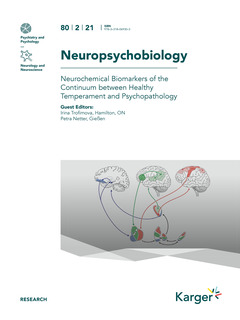Description
Neurochemical Biomarkers of the Continuum between Healthy Temperament and Psychopathology
Special Topic Issue: Neuropsychobiology 2021, Vol. 80, No. 2
Coordinators: Trofimova Irina, Netter Petra
Language: English
Subject for Neurochemical Biomarkers of the Continuum between...:
Keywords
Publication date: 04-2021
116 p. · Paperback
116 p. · Paperback
Description
/li>
This special topic issue tackles one of the oldest and most fundamental problems of psychology which are still unsolved: the biomarkers of biobehavioral individual differences (temperament) and psychopathology. Right from the very start of psychology and psychiatry as sciences there was a need to classify biobehavioral differences. It became clear that there is no working taxonomy without knowing how, biologically speaking, these differences are sustained despite universal sociocultural pressure for people to be attentive, energetic, social, intelligent, risk averse, empathetic, flexible, patient, and secure. There is obviously something biological going on that makes people respond differently to the same instructions or parenting. This special topic issue of Neuropsychobiology highlights two different approaches to biobehavioral taxonomies: ?biomarkers-first, taxonomy second? where we can identify neurophysiological mechanisms of behavioral regulation in mentally healthy people identifying the healthy range of neurobiological variations between people. We can then present psychopathology as deviations of these neurobiological mechanisms. The second approach, summarized as ?taxonomy first, biomarkers-second,? emerged when psychologists offered their classifications of temperament/personality traits and psychiatric disorders and then started looking for biomarkers that could be linked to these traits. The different approaches are discussed and evaluated, and this issue aims to show a direction on how to classify temperaments based on biomarkers. It focusses on the biomarkers of biobehavioral individual differences (temperament) and psychopathology using a spectrum of psychophysiological and analytic methods.
© 2024 LAVOISIER S.A.S.




